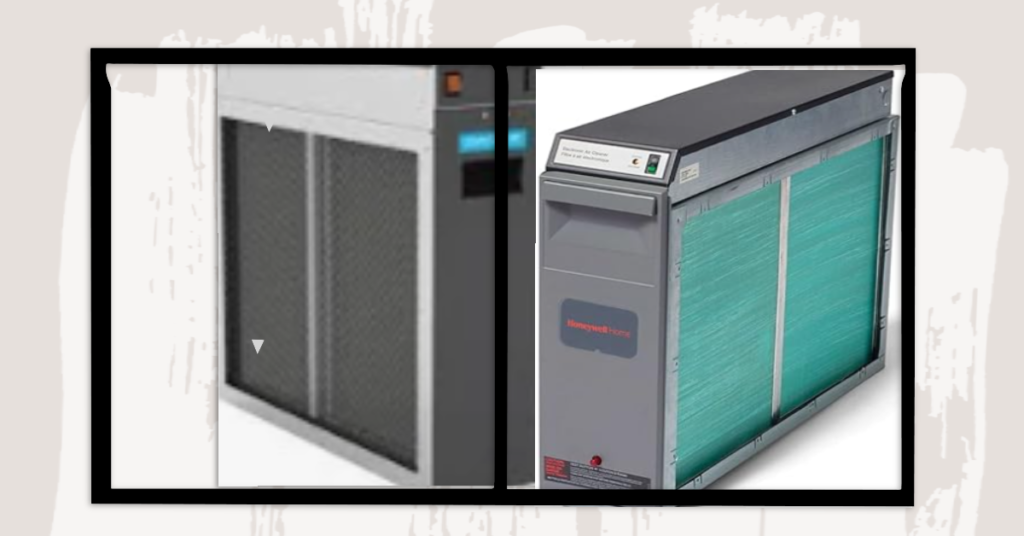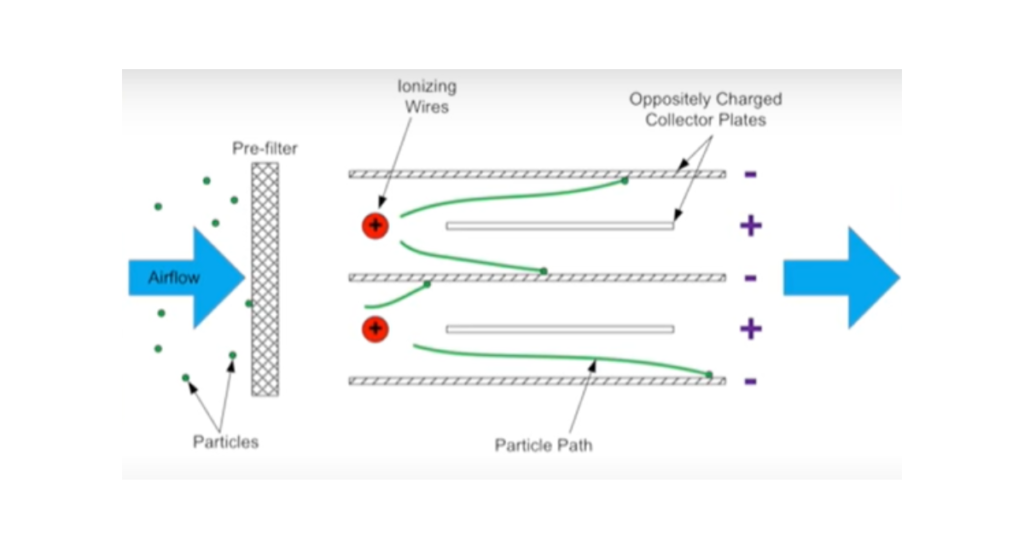Electronic air cleaners are often referred as electronic air purifiers. It uses electrostatic attraction for cleaning air. They offer a cutting-edge solution to the indoor air pollution issue. These innovative devices go beyond conventional air filtration, utilizing advanced technologies to efficiently remove allergens, pathogens and unwanted odors from the air you breathe.
In this guide, we will understand all about Electronic Air Cleaners in detail. We will discuss its types, working mechanisms, advantages, limitations. so without wasting much time let’s get started.
What are Electronic Air Cleaners?
Electronic air cleaners are advanced air purification devices that utilize electrostatic attraction to capture and remove airborne particles from the indoor air. Electronic air cleaners use electrical charges to trap pollutants, offering a more efficient and thorough method of air purification.

How Electronic Air Cleaners Work
Electronic air cleaners work through a process called electrostatic precipitation. Lets ake it simple to understand it. As air passes through the purifier, it encounters a series of charged plates or grids. These plates or grids create an electrostatic field that attracts and captures airborne particles, including dust, pollen, pet dander, smoke, and other pollutants. Once trapped, the particles adhere to the plates or grids until they are removed during the cleaning process.
- Electrostatic Charging of Particles: Particles in the air are given an electrostatic charge, making them easier to capture.
- Attraction and Collection Mechanisms: Charged particles are attracted to collector plates or other surfaces and removed from the air.
- Disinfection through UV-C Light: Some models use UV-C light to kill bacteria, viruses and mold spores.
The combination of these mechanisms ensures that electronic air cleaners are highly efficient at removing a wide range of airborne contaminants, including dust, allergens and microorganisms. Following diagram dipicts and explain these points.

Types of Electronic Air Cleaners
Electronic air cleaners come in various types, each with its unique features and mechanisms.
- Electrostatic Precipitators: These devices use electrostatic charges to trap particles.
- Ionizers: They release negatively charged ions to attract and remove airborne contaminants.
- UV-C Germicidal Lamps: These lamps use ultraviolet light to kill germs and pathogens.
- Hybrid Models: Combining multiple technologies for enhanced air purification.
Each type has its advantages and may be more suitable for specific situations.
Benefits of Electronic Air Cleaners
Electronic air cleaners offer multiple benefits, making them an good and attractive choice for those seeking cleaner indoor air. Some benefits listed below:
- Improved Air Quality: They effectively remove particles, allergens and contaminants, resulting in cleaner air.
- Allergy and Asthma Relief: Cleaner air can reduce allergy and asthma symptoms in individuals who suffer from these conditions.
- Reduction of Odors and VOCs: These devices help eliminate unpleasant odors and volatile organic compounds (VOCs).
- Energy Efficiency: Many electronic air cleaners are energy-efficient, helping you save on energy bills.
Following video gives you different view on Electronic air cleaners, you can watch it.
Limitations and Challenges
While electronic air cleaners offer many benefits, they also have limitations. Here are some drawbacks:
- Maintenance Requirements: Regular maintenance is required.
- Noise Levels: Some models can be noisy, which may not be suitable for quiet environments.
- Effectiveness in Large Spaces: They might not be as effective in large rooms or open spaces.
- Initial Costs: The upfront purchase price can be relatively high.
Factors to Consider When Choosing an Electronic Air Cleaner
When looking to improve indoor air quality, selecting the right air filter is crucial. One key metric to consider is the Minimum Efficiency Reporting Value (MERV) rating. Filters with a MERV rating of 10 or higher are top choices for efficiency, as they excel in capturing a wide range of particles, including dust, pollen, pet dander, and allergens. This higher MERV rating indicates superior particle capture capabilities, making them especially valuable for those with allergies or respiratory conditions.
However, it’s essential to strike a balance between filter efficiency and airflow, as very high MERV-rated filters can potentially restrict your HVAC system’s performance. Consulting an HVAC professional can help you make the right choice to ensure cleaner indoor air without compromising your system’s operation
- Room Size and Airflow: The size of your space and airflow patterns affect the device’s efficiency.
- Filter Type and Replacement Costs: Understanding the filter type and replacement costs is crucial for long-term use.
- Noise Tolerance: Consider your tolerance for noise and choose a model that suits your preferences.
- Initial Purchase Price: Different models come at varying price points, so find one that fits your budget.
Considering these factors will help you make a well-informed decision and ensure that the electronic air cleaner you choose meets your specific needs and expectations.
Conclusion
Electronic air cleaners play important role in enhancing indoor air quality and promoting a healthier living environment. The importance of clean air cannot be overstated, and these devices offer an effective solution against it. We have tried to cover much detailed points and we hope this article has provided you with valuable insights about electronic air cleaners and helps you make an informed decision when choosing the right one for your needs.
For more information on air purification, be sure to check out our Air Purifier Selection Guide.
FAQ
Do electronic air cleaners work?
Yes, electronic air cleaners can be effective in removing airborne particles and pollutants. They operate on the principle of electrostatic precipitation, which charges particles in the air and then collects them on oppositely charged plates or filters. This process can effectively capture a wide range of particles, including dust, pollen, pet dander, and some smoke particles.
What is the difference between electronic air cleaner and air purifier?
Electronic air cleaners are a type of air purifier, but there are different types of air purifiers. The main distinction is in the method of filtration:
Electronic Air Cleaners: These use electrostatic precipitation to capture particles. They charge particles in the air and then attract them to collection plates. They are generally effective at capturing larger particles but may be less efficient at removing very fine particles like viruses and some types of chemicals.
Traditional Air Purifiers: These use various methods like HEPA (High Efficiency Particulate Air) filters or activated carbon filters to physically trap or adsorb particles and pollutants. HEPA filters are particularly effective at capturing very small particles, including allergens and some viruses.
Does electronic air cleaner remove smoke?
Yes, electronic air cleaners can remove smoke particles from the air. They are generally effective at capturing larger smoke particles, such as those produced by burning wood or tobacco. However, they may be less efficient at capturing very fine smoke particles, like those generated by wildfires or fine particulate matter from industrial sources.
What is the major potential downside to using electronic air cleaners?
The major potential downside of electronic air cleaners is that some of them produce ozone as a byproduct of their operation. Ozone is a reactive gas that, when present in high concentrations, can be harmful to human health. It can irritate the respiratory system and exacerbate asthma or other lung conditions. To mitigate this downside, it’s important to choose an electronic air cleaner that is ozone-free and meets safety standards. Additionally, electronic air cleaners may require regular maintenance, including cleaning the collection plates, to maintain their effectiveness.
What is the best electronic air cleaner?
Determining the “best” electronic air cleaner depends on your specific needs and preferences. Several reputable brands offer effective electronic air cleaners. Some popular options include Honeywell, Trane, and Aprilaire. To find the best one for your situation, consider factors like the size of the area you want to purify, the types of particles you need to remove, and any specific features you desire, such as a quiet operation or remote control. Reading customer reviews and consulting experts or air quality professionals can help you make an informed decision.
What is the difference between ionizer and electronic air cleaner?
An ionizer is a type of electronic air cleaner, but there are differences between the two:
Ionizer: An ionizer, or ionizing air purifier, emits negative ions into the air. These ions attach to airborne particles, making them heavier and causing them to fall to the ground or stick to surfaces. Ionizers can be effective at removing some types of particles from the air, but they may not capture them all. They are often used in combination with other air purification technologies.
Electronic Air Cleaner: An electronic air cleaner, also known as an electrostatic precipitator, charges particles in the air and then collects them on oppositely charged plates or filters. This method is more effective at capturing a wider range of particles, including dust, pollen, and some smoke particles. It is a type of air purifier that uses electrostatic attraction for particle removal.
Do electronic air cleaners produce ozone?
Some electronic air cleaners can produce ozone as a byproduct of their operation. This is a significant concern because ozone can be harmful to human health, particularly when present in high concentrations. Ozone can irritate the respiratory system and worsen conditions such as asthma. To ensure your electronic air cleaner does not produce ozone, look for models that are ozone-free and meet safety standards. Check the product specifications and labels to confirm that it is ozone-safe. If you have concerns about ozone, it may be best to choose an air purifier that does not produce ozone, such as those that use HEPA filters or activated carbon filters.
Do electronic air cleaners reduce dust?
Yes, electronic air cleaners can effectively reduce dust in your indoor environment. They work by charging particles in the air and collecting them on oppositely charged plates or filters. This process is particularly efficient at capturing dust particles, including fine dust, pet dander, and other airborne particles.
How often do you need to clean an electronic air cleaner?
The frequency of cleaning an electronic air cleaner varies depending on the specific model and its usage. Generally, it’s recommended to clean the collection plates or filters regularly to maintain the unit’s effectiveness. A typical maintenance schedule might include cleaning every 2-4 weeks, but it can vary based on the manufacturer’s instructions and the local air quality conditions.
DheerajSonwane is a dedicated writer with expertise in air purification technologies. He focuses on providing well-researched content to help readers improve indoor air quality in homes and businesses. As the lead writer at AirPurifierMaster.com, Dheeraj offers practical advice his insightful reviews guide individuals in choosing the best air purifiers for their needs.


1 thought on “Electronic Air Cleaners : Your Complete Guide”